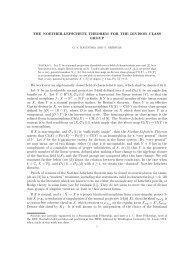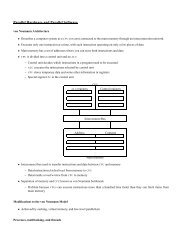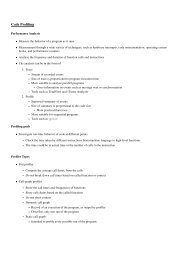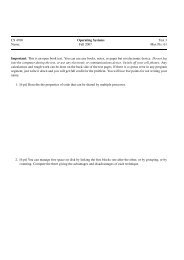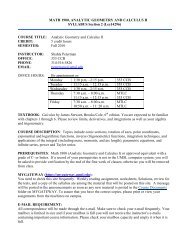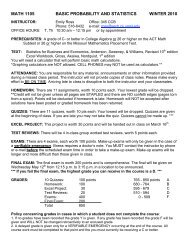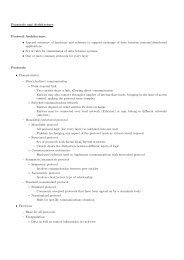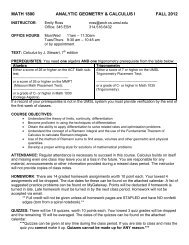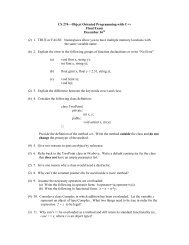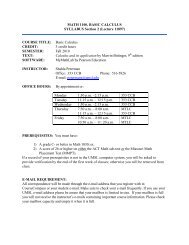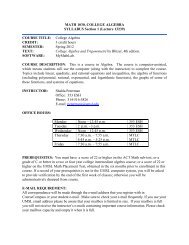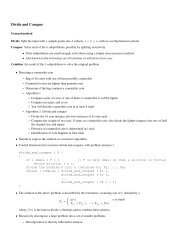here - UMSL : Mathematics and Computer Science - University of ...
here - UMSL : Mathematics and Computer Science - University of ...
here - UMSL : Mathematics and Computer Science - University of ...
You also want an ePaper? Increase the reach of your titles
YUMPU automatically turns print PDFs into web optimized ePapers that Google loves.
IEEE TRANS. SIGNAL PROC. 15<br />
w<strong>here</strong> ˜W 0 (ω), ˜W 1 (ω), <strong>and</strong> W 0 (ω), W 1 (ω) are given by (38) <strong>and</strong> (37) for some parameters a 0 , c 0 , d 0 <strong>and</strong> a 1 , c 1 , d 1<br />
respectively. In this case, ˜p has a larger filter length than p. We will use {˜p, ˜q (1) , ˜q (2) } as the analysis filter bank<br />
(for multiresolution decomposition algorithm) <strong>and</strong> use {p, q (1) , q (2) } as the synthesis filter bank (for multiresolution<br />
reconstruction algorithm). Hence, we will construct φ to be smoother than its dual ˜φ.<br />
If<br />
3a − d − 6c<br />
a 1 =<br />
3(3c − d) , c (3c + 2a)(6c + d − 3a)<br />
1 =<br />
9a(3c − d)(6c + 6a + d) , d 1 = 3c − 18acc 1 + 6adc 1 − a<br />
,<br />
a(3c − d)<br />
then both p(ω) <strong>and</strong> ˜p(ω) have sum rule order 2. If in addition,<br />
d = − 3 a (4a2 + 11ca + 9c 2 ),<br />
then p(ω) has sum rule order 3. T<strong>here</strong> are two free parameters a, c. (We cannot choose a, c further such that ˜p(ω)<br />
also has sum rule order 3.) With many choices <strong>of</strong> different values for a, c, the resulting φ ∈ C 1 while ˜φ has certain<br />
smoothness order. For example, if we choose a = − 1 3 , c = 2, then the corresponding ˜φ ∈ W 0.0758 <strong>and</strong> φ ∈ W 2.3426 ;<br />
with a = − 1 3 , c = 1, the resulting ˜φ ∈ W 0.3284 <strong>and</strong> φ ∈ W 2.2354 ; <strong>and</strong> if<br />
a = − 1 3 , c = 1 2 , (41)<br />
then ˜φ ∈ W 1.0507 , φ ∈ W 1.9145 . In Appendix B we provide the corresponding biorthogonal filter banks, denoted as<br />
Bio (6,8) , when a, c are given by (41). In this case, the corresponding d, a 1 , c 1 , d 1 defined above for sum rule orders<br />
are<br />
d = 31 4 , a 1 = 47<br />
75 , c 1 = 94<br />
1575 , d 1 = 274<br />
525 .♦<br />
Except for W (ω) <strong>and</strong> ˜W (ω), we may use other matrices as blocks to build the biorthogonal filter banks. For<br />
example, we may use<br />
⎡<br />
1 e 0 (1 + 1 x + y) + e 1(xy + 1<br />
xy + y x ) e 0(1 + x + 1 y ) + e 1(xy + 1<br />
xy + x y ) ⎤<br />
Z(ω) = ⎣ 0 1 0<br />
⎦ , (42)<br />
0 0 1<br />
w<strong>here</strong> e 0 , e 1 are constants. For Z(ω) defined by (42), ˜Z(ω) = (Z(ω) −1 ) ∗ is given by<br />
⎡<br />
⎤<br />
1 0 0<br />
˜Z(ω) = ⎣ −e 0 (1 + x + 1 y ) − e 1(xy + 1<br />
xy + x y ) 1 0 ⎦ . (43)<br />
−e 0 (1 + 1 x + y) − e 1(1 + 1<br />
xy + y x ) 0 1<br />
Clearly both Z(ω) <strong>and</strong> ˜Z(ω) satisfy (34) <strong>and</strong> (35). Thus if {p, q (1) , q (2) } <strong>and</strong> {˜p, ˜q (1) , ˜q (2) } are given by (39) for<br />
some n ∈ Z + with each U k (ω) is a W (ω) in (37), a ˜W (ω) in (38), a Z(ω) in (42), or a ˜Z(ω) in (43), <strong>and</strong><br />
Ũ k (ω) = (U k (ω) −1 ) ∗ is the corresponding ˜W (ω) (W (ω), ˜Z(ω), or Z(ω) accordingly), then {p, q (1) , q (2) } <strong>and</strong><br />
{˜p, ˜q (1) , ˜q (2) } are biorthogonal FIR filter bank with 6-fold axial symmetry.<br />
For a pair <strong>of</strong> filter banks {p s , q s (1) , q s (2) } <strong>and</strong> {˜p s , ˜q s (1) , ˜q s<br />
(2) }, using<br />
[p(ω), q (1) (ω), q (2) (ω)] T = L(M T ω)[p s (ω), q s (1) (ω), q s (2) (ω)] T ,<br />
[˜p(ω), ˜q (1) (ω), ˜q (2) (ω)] T = ˜L(M T ω)[˜p s (ω), ˜q s (1) (ω), ˜q s (2) (ω)] T ,<br />
w<strong>here</strong> L(ω) = Z(ω) <strong>and</strong> ˜L(ω) = ˜Z(ω) or L(ω) = ˜Z(ω) <strong>and</strong> ˜L(ω) = Z(ω), to build another pair <strong>of</strong> filter banks<br />
{p, q (1) , q (2) } <strong>and</strong> {˜p, ˜q (1) , ˜q (2) } is called the lifting scheme method. See [53] for the lifting scheme method to<br />
construct biorthogonal filter banks (see also [54] for the similar concept <strong>of</strong> the lifting scheme). Next, as an example,<br />
we show how W (ω) <strong>and</strong> Z(ω) reach some interesting biorthogonal filter banks, including those constructed in<br />
[41] (for regular nodes).



